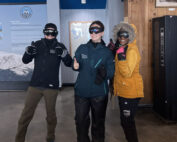Wind Chill
2009-10-17 21:21:28.000 – Mike Carmon, Staff Meteorologist
NULL
When someone asks me what it’s like on the summit, I have a go-to phrase that works about 90% of the time-‘cold and windy.’
I generally use this phrase in a tongue-in-cheek manner for a humorous effect. All kidding aside however, those terms are relative, but I think most of those who have visited the summit, especially in the winter, would agree that assessment is more than fair.
We are a weather observatory, but in addition to observing the weather, we attempt to predict it. Unfortunately, there are many individuals hiking above tree line that cannot fully comprehend the harsh environment the higher summits can be at any given time, simply because these extreme conditions are so rare on the planet. In an attempt to convey the consequences of being unprepared in this environment, we use many different tools. One of them is the wind chill factor.
Moving air feels much colder against the body than stagnant air. Air moving against your skin removes heat from your body. And the faster the wind blows, the more air comes in contact with your body, and more and more heat is removed. That is why as wind speed increases, wind chill decreases.
It is important to remember that the wind chill is an apparent temperature, and not an actual temperature. And if you are adequately dressed with no exposed skin, the wind chill factor does not retain much value. But if you have even the slightest amount of skin exposed to the elements, the wind chill becomes a useful tool. Among other things, it will give an indication of how quickly frostbite can occur on that patch of skin that is left unshielded from the environment. For a more thorough explanation, and some history, as well as a wind chill chart and calculator, check out our wind chill page.
Mike Carmon, Staff Meteorologist
Team Flags Return for Seek the Peak’s 25th Anniversary
Team Flags Return for Seek the Peak's 25th Anniversary By MWOBS Staff Mount Washington Observatory is looking forward to continuing a much-loved tradition for Seek the Peak’s 25th Anniversary: Team flags. In inviting teams
Meet Summer Interns Zakiya, Max and Maddie
Meet Summer Interns Zakiya, Max and Maddie By MWOBS Staff We are excited to welcome six teammates to the summit of Mount Washington this summer! During their internship, these students and graduates will play
Saying Goodbye to the Summit
Saying Goodbye to the Summit By Alexis George After an extraordinary last three years working as a Weather Observer and Meteorologist, I am excited to pursue a different career. As sad I as am




